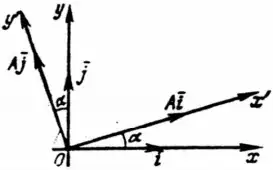In the plane $Oxy,$ one a rotation of a vector around the origin by $\theta$ is a linear map (check the image below). How to find the rotation expression and the rotation matrix ?

Applied example. Given the triangle $MNP$ with $M\left ( 1, 1 \right ), N\left ( 1, 2 \right ), P\left ( 3, 3 \right ).$ Find the image of the triangle $MNP$ by using that rotation with $\theta= \frac{\pi}{4},$ then draw a diagram for the example.
I follow the reasoning in Qiaochu Yuan's answer- https://math.stackexchange.com/a/1293/822157
My attempt. Given a vector $\left ( x, y \right )\in\mathbb{R}^{2}.$ Let $\alpha$ be the angle determined by $\left ( x, y \right ),$ the $x-$axis and $r= \sqrt{x^{2}+ y^{2}}$ its length. Then, of course
$$x, y= r\cos\alpha, r\sin\alpha$$
If you rotate $\left ( x, y \right )$ an angle $\theta,$ you'll obtain the vector $\left ( {x}', {y}' \right ):$
$${x}', {y}'= r\cos\left ( \alpha+ \theta \right ), r\sin\left ( \alpha+ \theta \right )$$
Now you apply those sum and difference formulas and get
$${x}'= r\cos\alpha\cos\theta- r\sin\alpha\sin\theta= x\cos\theta- y\sin\theta$$
$${y}'= r\sin\alpha\cos\theta+ r\cos\alpha\sin\theta= x\sin\theta+ y\cos\theta$$
Which is the same as saying that $\left ( {x}', {y}' \right )$ is obtained from $\left ( x, y \right )$ multiplying with the matrix
$$\begin{pmatrix} \cos\theta & -\sin\theta\\ \sin\theta & \cos\theta \end{pmatrix}$$
Since the rotation $\left ( x, y \right )\mapsto\left ( {x}', {y}' \right )$ is the same as multiplication by a matrix, it is a linear transformation.
Then, what should I do for the applied example ? Hope you can help.
Asked
Active
Viewed 127 times
1
-
2That's it, that's the rotation matrix – Dhanvi Sreenivasan Jun 16 '21 at 08:39
-
@DhanviSreenivasan how is the rotation expression ? – Jun 16 '21 at 08:41
-
1The equations which you used to derive the matrix – Dhanvi Sreenivasan Jun 16 '21 at 08:42
-
1Which is exactly the question? Is it (A) How to get the image of $\Delta MNP$ by the rotation with angle $\pi/4$? Or (B) which is the matrix obtained by plugging in $\theta=\pi/4$ into $$\begin{bmatrix} \cos\theta & -\sin\theta\ \sin\theta & \cos\theta \end{bmatrix}\ ?$$ Or (C) .., something else?! – dan_fulea Jun 16 '21 at 11:47
-
@dan_fulea I added something, thanks a real lot ! – Jun 16 '21 at 11:56
-
1After the edit, i see only two questions. The first one is: How to find the rotation expression and the rotation matrix? And it is answered in the following lines in the OP. (We have a formula for $(x', y')$, and also how to obtain the vector with these components from the starting components,$$\begin{bmatrix}x'\y'\end{bmatrix} = \begin{bmatrix}\cos\theta&-\sin\theta\\sin\theta&\cos\theta\end{bmatrix}\begin{bmatrix}x\y\end{bmatrix}\ .$$The matrix involved is shown. The second question is "What should I do next?" Next refers to something unclear... is it the Applied example? – dan_fulea Jun 16 '21 at 12:28
-
@dan_fulea I'm sorry. My bad. – Jun 16 '21 at 12:52
-
1Why are you rotating by angle $\theta$ when your question asked specifically to rotate by angle $\alpha$? – Ted Shifrin Jun 16 '21 at 22:57
1 Answers
0
Since rotation is a linear transformation, it maps straight lines into straight lines and so maps a triangle into a triangle. Determine the points that (1, 1), (1, 2), and (3, 3) are mapped into. The triangle with vertices (1, 1), (1, 2), (3, 3) is mapped into the triangle with those new vertices.
user247327
- 18,710